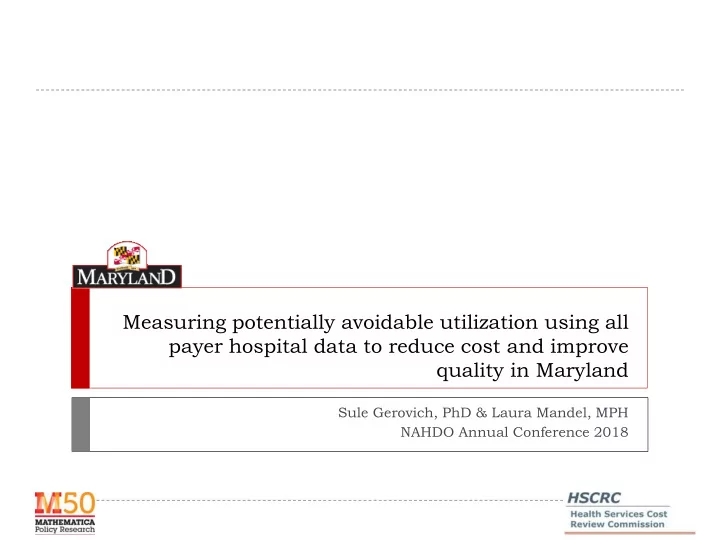

Measuring potentially avoidable utilization using all payer hospital data to reduce cost and improve quality in Maryland Sule Gerovich, PhD & Laura Mandel, MPH NAHDO Annual Conference 2018
Unique All-Payer Hospital Payment System in Maryland Since the late 1970s, Maryland sets hospital rates for all public and private payers. Essentially, hospitals receive a rate for each of their services from the state for all payers. Medicare, Medicaid, Private, and Uninsured pay off of the same rate. Rates are updated annually on a prospective basis and differ for each hospital. Higher cost hospitals such as academic medical centers have higher rates. Claim processing and benefit coverage are determined by each payer. 2
The State of Maryland Maryland Acute Care Hospitals 47 Acute general hospitals, all nonprofit The Johns Hopkins Hospital The University of Maryland 54 % of population with employer coverage, 16% in Medicaid, 14% in Medicare. HMO penetration rate 34%* 6 Million people 18% of population > age 64 3rd highest income per capita state High poverty rates (urban and rural) * Source: Kaiser Family Foundation State Health Facts
New All-Payer Model Agreement with CMS Moved from unit price to total cost per capita measure Phase I: 2014- Phase II: 2019 + 2019 Inpatient Cost T otal Health per Discharge T otal Hospital Cost per Capita Cost per Capita All-Payer hospital cost per capita limit is set for 3.58 %. Quality and performance targets to promote care improvement. Payment transformation away from fee-for-service for hospital services. Models to focus on total health spending and transformation 4
Global Budget Model: prospective revenue budget with annual adjustments The Global Budget Model: revenue budget with annual adjustments Efficient High Enhanced base Quality The initial revenue budget would Hospital be based on historical revenue Adjust for This budget could be enhanced or Limited Current reduced based on hospital Utilization revenue base Changes efficiency and utilization The budget would be adjusted annually for changes in market Inefficient Reduced base shifts, population and quality Low Quality Hospital 5
Potentially Avoidable Utilization (PAU) Savings Program Main revenue model for global PAU Definition: “Hospital care that is unplanned and can be prevented budget is to improve through improved care coordination, population health and reduce effective primary care and improved population health.” the hospital utilization. State created savings program Potentially Readmissions/ Avoidable measuring Potentially Avoidable Revisits Admissions Utilization (PAU) to increase incentives to focus on population health. Components of PAU Calculate Percent of Revenue Attributable to PAU 6 6
PAU measure specifications Readmissions 30 day all-cause unplanned readmissions Potentially avoidable admissions Hospitalizations from ambulatory-care sensitive conditions that may be preventable through effective primary care and care coordination. Identified using Agency for Healthcare Research and Quality (AHRQ) Preventable Quality Indicator (PQIs) software Maryland measures PQIs on inpatient and observation stays greater than 24 hours. AHRQ specifications are limited to inpatient.
AHRQ PQIs AHRQ methodology for area based population health measures are adapted for hospital revenue models.
Data Source All Maryland hospitals submit all-payer confidential claim-level hospital abstract data Inpatient and hospital outpatient claims Monthly submission Approximately 700,000 inpatient discharges and 5.7 million outpatient visits annually. Data includes the following information Demographic (including medical record and provider identifiers) Financial (payers and charges) Clinical (including dates of service, diagnoses, disposition) State-designated health information exchange (CRISP) creates unique patient identifier for every patient seen in MD hospitals
2017 PQI rate per 100k adults by zip code PQI counts excludes readmissions 10
Distribution of PAU cost in 2017
Statewide PQI Results Per Capita PQI rate (inpatient and observation stays >24 hours, inclusive of readmits) declined by 7.9% between 2013 and 2017.
Hospital level variation in PAU % PAU cost as a % of total hospital cost sorted from largest to smallest in 2013 PAU % Hospitals at the highest end of PAU% were able to reduce the proportion of PAU compared to total cost.
Future of PAU As Maryland moves into the Total Cost of Care (TCOC) Model (2019-2027+), focus is on community and population health Transition to a per-capita approach that allows for hospital geographic accountability Allow for population-specific measures Supports the population health focus (i.e. AHRQ pediatric measures) of the TCOC Model Improve fairness between hospitals with different service line mixes Enable potential risk adjustment
Recommend
More recommend